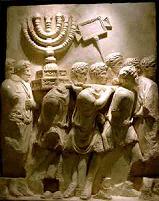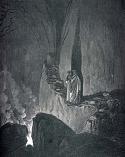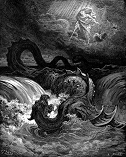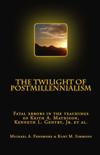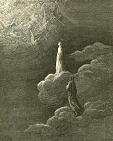Reuss on the Number of the Beast
Excerpts from the Parousia
by J. Stuart Russell
(1878)
(Rev. xiii. 18.)
‘It would form a very singular history were we to recount all that has been said by theologians with reference to the number 666 in the Revelation. This is not, however, the place to do so, and it is generally mere waste of time to refute palpable errors and absurd hallucinations. Our texts are so clear to those who have eyes to see and comprehend, that the simple statement of their true meaning ought at once to dissipate the clouds gathered round them by dogmatic prejudices, interested imaginations, and political pre-constructions.
‘The number of the beast, 666, is the number of a man, ariqmoz, anqrwpou, says the prophet. It is the number of a name, he says again, and that name is written on the forehead of those who are the loyal subjects and worshippers of the beast. But the beast itself is a personal being---Antichrist, and does not stand for some abstract idea. From this it follows that the number 666 does not represent a period of ecclesiastical history, as is maintained in the interpretation of orthodox Protestant theologians and of pietistic chiliasts of the school of Bengel. Nor does it stand for a common name, and to characterise a power, an empire, as, for example, Roman Paganism, as Irenaeus sought to show with his Aateinoz, which has been adopted by all subsequent interpreters who have failed to invent anything more inadmissible still, and which Protestants have eagerly made use of in the interest of their anti-papal polemics. The terms "Latium," "Latini," had no existence in the first century but in the poetry and local geography of the Campagna of Rome, and, as the name of a language, was utterly unknown in any form within apostolic sphere (Luke xxiii. 38; John xix. 20).
‘The number 666 must, then, contain a proper name, the name of the political and historical personage who was to play the part of Antichrist in all the great revolutions awaiting the Judaeo-Christian world. After reading Daniel and the Second Epistle to the Thessalonians we know what is the subject. Our author finally proceeds to tell us of whom he speaks.
‘Here, then, is the difficulty (if difficulty it be) which has most often misled even those who have approached the problem with a spirit free from prejudice and illusion. The beast of the thirteenth chapter is not an individual, but the Roman Empire, regarded as a power. The writer himself tells us (chap. xvii.) that the seven heads of the beast represent the seven hills on which his capital is built; and again, seven kings who have reigned, or still reign, there. This is quite true, but he tells us quite as plainly that this beast is at the same time one of the seven heads, a combination apparently inconceivable and more than paradoxical, but at the same time very natural, and even necessary. The idea of a power, especially of a hostile influence, always tends to assume a concrete form, to personify itself in the popular mind. The ideal monster becomes an individual; the principle assumes a distinct human shape, and under this personal form ideas become popularised, till individuals come in their turn to be the permanent representatives of ideas and influences which outlive themselves. To most men a proper name conveys more than a definition, and is more apt to excite warm and living feeling. The pagan power, idolatry, blasphemy, persecution, all that stirs the lawful antipathies of the church, all that inspires it with horror, and wrings from it the cry of woe, would naturally be individualised and concentrated in the person of him who, a few years before the destruction of Jerusalem, had filled up the measure of his crimes. The beast is, then, at once the Empire and the Emperor, and the name of the latter is on the lips of the thoughtful reader before we utter it. Let us, however, cast upon it all the light of historic science.
‘An attentive reading of chap. xi. will have already brought us to the conviction that this book was written before the destruction of Jerusalem. The temple and its inner court, with the great altar, are the measured---destined, that is to say, to be preserved (Zech. ii.), while the rest of the city is given up to the Pagans and devoted to sacrilege. These passages could not have been framed in view of the state of things which existed after the year 70. But the indications given in chap. xvii. are still more decisive. We shall maintain that Rome is here spoken of till it can be shown that in the age of the apostles there existed another city built upon seven hills, urbem septicollem, in which the blood of the witnesses of Christ had been shed in torrents (vers. 6, 9). This city, or this empire, has seven kings. The revelations of Daniel, of Enoch, and of Esdras follow the same chronological plan, all counting successions of kings to put the reader upon the track of the dates. Of those seven kings five are already dead (ver. 10), the sixth is reigning at this very time. The sixth emperor of Rome was Galba, an old man, seventy-three years of age at his accession. The final catastrophe, which was to destroy the city and the empire, was to take place in three years and a half, as has already been noted. For this one simple reason the series of emperors will include only one after the then reigning monarch, and he will reign but a little while. The writer does not know him, but he knows the relative duration of his reign, because he knows that Rome will, in three years and a half, perish finally, never to rise again.
‘There shall come an eighth emperor, he is one of the seven, and is at the same time the beast that was, but at the moment, is not. This must refer, then, to one of the previous emperors, who is to come again a second time, but as Antichrist, that is, invested with all the power of the devil, and for the special end of fighting against the Lord. As it is said that, at the time the vision is written, he is not, but has already been, he must be one of the first five emperors. He has been already wounded to death (chap. xiii. 3), so that there is something miraculous in his reappearance. It cannot, then, be Augustus, Tiberius, or Claudius, who none of them came to a violent end, and who are further place out of the question by the fact that none of these stood in hostile relations to the church. This reason will also exclude Caligula. There remains only Nero; but everything concurs to point him out as the personage thus mysteriously designated. So long as Galba reigned, and even long after that, the people did not believe Nero to be dead; they supposed him hidden somewhere, and ready to return and avenge himself on his enemies. The Messianic ideas of the Jews, which had become vaguely diffused through the West (as we learn from Tacitus and Suetonius), blending with these popular notions, suggested to the credulous the idea that Nero would come again from the East, to regain his throne by the aid of the Parthians. Many false Neros appeared. These popular fancies spread also among Christians. Visions were of common occurrence, and the Fathers of the church perpetuate the same tradition through several centuries later.
‘Lastly, that nothing may be wanting to the full evidence, our book names Nero, so to speak, in every character. The name Nero is contained in the number 666. The mechanism of the problem is based upon one of the cabalistic artifices in use in Jewish hermeneutics, which consisted in calculating the numerical value of the letters composing a word. this method, called ghematria, or geometrical, that is, mathematical, and used by the Jews in the exegesis of the Old Testament, has given much trouble to our learned men, and has led them into a maze of errors. All ancient and modern alphabets have been placed under contribution, and all imaginable combinations of figures and letters have been tried in turn. It has been made to yield almost all the historical names of the past eighteen centuries,---Titus Vespasian and Simon Gioras, Julian the Apostate and Genseric, Mohomet and Luther, Benedict IX. and Louis XV., Napoleon I. and the Duke de Reichstadt,---and it would not be difficult for any of us, on the same principles, to read in it one another’s names. In truth, the enigma was not so hard, though it has only been solved by exegesis in our own days. It was so little insoluble that several contemporary scholars found the clue simultaneously, and without knowing anything of one another’s labours. The ghematria is a Hebrews ar. The number has to be deciphered by the Hebrew Alphabet: rsq nwrn reads "Nero Caesar":---

‘The most curious point is that there exists a very ancient reading which gives 616. This might be the work of a Latin reader of the Revelation who had found the solution, but who pronounced Nero like the Romans, while the writer of the Revelation pronounced it like the Greeks and Orientals. The removal of the final n gives fifty less.’
To receive Kurt Simmons’ e-mail newsletter, The Sword & The Plow, click the Subscribe link:
All rights reserved.
